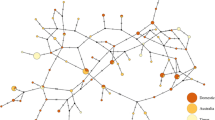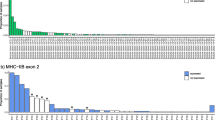Abstract
The endangered Yangtze finless porpoise is found in the middle and lower reaches of the Yangtze River and its adjoining big lakes. To explore the major histocompatibility complex (MHC) genetic diversity and allelic distribution patterns across its range, we investigated variation at DQB exon 2. From 76 porpoises, we identified 18 DQB sequences. The freshwater Yangtze populations had much higher allelic diversity than marine populations. Among these freshwater populations, the middle-reach population had higher allelic diversity than the lower-reach population. The high DQB diversity level, relative to that of a neutral mtDNA locus, suggests that balancing selection is acting at the DQB gene and that rapid evolution and local positive selection play critical roles in generating and retaining high MHC diversity in the freshwater population. As the balancing selection might be driven by environmental pathogens, we suggest that maintaining MHC variation should be a high priority in the conservation and management of this endangered population, especially as an ex situ conservation strategy.




Similar content being viewed by others
References
Aguilar A, Garza JC (2006) A comparison of variability and population structure for major histocompatibility complex and microsatellite loci in California coastal steelhead (Oncorhynchus mykiss Walbaum). Mol Ecol 15:923–937
Aguilar A, Roemer G, Debenham S, Binns M, Garcelon D, Wayne RK (2004) High MHC diversity maintained by balancing selection in an otherwise genetically monomorphic mammal. Proc Natl Acad Sci USA 101:3490–3494
Baker CS, Vant MD, Dalebout ML, Lento GM, O’Brien SJ, Yuhki N (2006) Diversity and duplication of DQB and DRB-like genes of the MHC in baleen whales (suborder: Mysticeti). Immunogenetics 58:283–296
Brown JH, Jardetzky TS, Gorga JC, Stern LJ, Urban RG, Strominger JL, Willey DC (1993) Three-dimensional structure of the human class II histocompatibility antigen HLA-DR1. Nature 364:33–39
Bryja J, Galan M, Charbonnel N, Cosson JF (2006) Duplication, balancing selection and trans-species evolution explain the high levels of polymorphism of the DQA MHC class II gene in voles (Arvicolinae). Immunogenetics 58:191–202
Bugawan TL, Erlich HA (1991) Rapid typing of HLA-DQB1 DNA polymorphism using nonradioactive oligonucleotide probes and amplified DNA. Immunogenetics 33:163–170
Cohen S (2002) Strong positive selection and habitat-specific amino acid substitution patterns in MHC from an estuarine fish under intense pollution stress. Mol Biol Evol 19:1870–1880
Edwards SV, Hedrick PW (1998) Evolution and ecology of MHC molecules: from genomics to sexual selection. Trends Ecol Evol 13:305–311
Gao A, Zhou K (1995) Geographical variation of external measurements and three subspecies of Neophocaena phocaenoides in Chinese waters. Acta Theriol Sinica 15:81–92 (in Chinese with English abstract)
Hambuch TM, Lacey EA (2002) Enhanced selection for MHC diversity in social tuco-tucos. Evolution 56:841–845
Hayashi K, Nishida S, Yoshida H, Goto M, Pastene LA, Koike H (2003) Sequence variation of the DQB alleles in the cetacean MHC. Mamm Stud 28:89–96
Hayashi K, Yoshida H, Nishida S, Goto M, Pastene LA, Kanda N, Baba Y, Koike H (2006) Genetic variation of the MHC DQB locus in the finless porpoise (Neophocaena phocaenoides). Zool Sci 23:147–153
He S, Wang D, Wang W, Chen D, Zhao Q, Gong W (2005) Genetic diversity in the Yangtze finless porpoise by RAPD analysis. High Technol Lett 11:207–210
Hedrick PW, Parker KM, Lee RN (2001) Using microsatellite and MHC variation to identify species, ESUs, and MUs in the endangered Sonoran topminnow. Mol Ecol 10:1399–1412
Hilton-Taylor C (2000) 2000 IUCN red list of threatened species. IUCN-The World Conservation Union, Gland, Switzerland
Hoelzel AR, Stephens JC, O’Brien SJ (1999) Molecular genetic diversity and evolution at the MHC DQB locus in four species of pinnipeds. Mol Biol Evol 16:611–618
Hughes AL (1991) MHC polymorphism and the design of captive breeding programs. Conserv Biol 5:249–251
Hughes AL, Nei M (1988) Pattern of nucleotide substitution at major histocompatibility complex class I loci reveals overdominant selection. Nature 335:167–170
Hughes AL, Nei M (1989) Nucleotide substitution at major histocompatibility complex class II loci: evidence for overdominant selection. Proc Natl Acad Sci USA 86:958–962
Hughes AL, Yeager M (1998) Natural selection at major histocompatibility complex loci of vertebrates. Annu Rev Genet 32:415–435
Jeanmougin F, Thompson JD, Gouy M, Higgins DG, Gibson TJ (1998) Multiple sequence alignment with ClustalX. Trends Biochem Sci 23:403–405
Jukes TH, Cantor CR (1969) Evolution of protein molecules. In: Munro HN (ed) Mammalian protein metabolism III. Academic Press, New York, pp 21–132
Klein J (1986) Natural history of the major histocompatibility complex. Wiley, New York
Klein J, Takahata N (1990) The major histocompatibility complex and the quest for origins. Immunol Rev 113:5–25
Kumar S, Tamura K, Nei M (2004) MEGA3: integrated software for molecular evolutionary genetics analysis and sequence alignment. Brief Bioinform 5:150–163
Landry C, Bernatchez L (2001) Comparative analysis of population structure across environments and geographical scales at major histocompatibility complex and microsatellite loci in Atlantic salmon (Salmo salar). Mol Ecol 10:2525–2539
Martínez-Agüero M, Flores-Ramírez S, Ruiz-Garcíal M (2006) First report of major histocompatibility complex class II loci from the Amazon pink river dolphin (genus Inia). Genet Mol Res 5:421–431
Miller HC, Lambert DM (2004) Genetic drift outweighs balancing selection in shaping post-bottleneck major histocompatibility complex variation in New Zealand robins (Petroicidae). Mol Ecol 13:3709–3721
Murray BW, White BN (1998) Sequence variation at the major histocompatibility complex DRB loci in beluga (Delphinapterus leucas) and narwhal (Monodon monoceros). Immunogenetics 48:242–252
Murray BW, Malik S, White BN (1995) Sequence variation at the major histocompatibility complex locus DQB in beluga whales (Delphinapterus leucas). Mol Biol Evol 12:582–593
Nei M, Gojobori T (1986) Simple methods for estimating the numbers of synonymous and nonsynonymous nucleotide substitutions. Mol Biol Evol 3:418–426
Nei M, Gu X, Sitnikova T (1997) Evolution by the birth-and-death process in multigene families of the vertebrate immune system. Proc Natl Acad Sci USA 94:7799–7806
Nigenda-Morales S, Flores-Ramírez S, Urbán RJ, Vázquez-Juárez R (2008) MHC DQB-1 polymorphism in the Gulf of California fin whale (Balaenoptera physalus) population. J Hered 99:14–21
Reeves RR, Wang JY, Leatherwood S (1997) The finless porpoise, Neophocaena phocaenoides (G. Cuvier, 1829): a summary of current knowledge and recommendations for conservation action. Asian Mar Biol 14:111–143
Richardson DS, Westerdahl H (2003) MHC diversity in two Acrocephalus species: the outbred great reed warbler and the inbred Seychelles warbler. Mol Ecol 12:3523–3529
Richman AD, Herrera LG, Nash D (2003) Evolution of MHC class II Eβ diversity within the genus Peromyscus. Genetics 164:289–297
Sambrook J, Fritsch E, Maniatis T (1989) Molecular cloning: a laboratory manual, 2nd edn. Cold Spring Harbor Laboratory Press, Cold Spring Harbor, NY
Schaschl H, Suchentruk F, Hammer S, Goodman SJ (2005) Recombination and the origin of sequence diversity in the DRB MHC class II locus in chamois (Rupicapra spp.). Immunogenetics 57:108–115
Slade RW (1992) Limited MHC polymorphism in the southern elephant seal: implications for MHC evolution and marine mammal population biology. Proc Biol Sci 249:163–171
Sommer S (2005) The importance of immune gene variability (MHC) in evolutionary ecology and conservation. Front Zool 2:1–18
Takahata N, Satta Y, Klein J (1992) Polymorphism and balancing selection at major histocompatibility complex loci. Genetics 130:925–938
Trowsdale J, Groves V, Arnason A (1989) Limited MHC polymorphism in whales. Immunogenetics 29:19–24
Wang D, Hao Y, Wang K, Zhao Q, Chen D, Wei Z, Zhang X (2005) The first Yangtze finless porpoise successfully born in captivity. Environ Sci Pollut Res 5:247–250
Wang K, Wang D, Zhang X, Pfluger A, Barrett L (2006) Range-wide Yangtze freshwater dolphin expedition: the last chance to see Baiji? Environ Sci Pollut Res 13:418–424
Xia J, Zheng J, Wang D (2005) Ex situ conservation status of an endangered Yangtze finless porpoise population (Neophocaena phocaenoides asiaeorientalis) as measured from microsatellites and mtDNA diversity. ICES J Mar Sci 62:1711–1716
Xu S, Sun P, Zhou K, Yang G (2007) Sequence variability at three MHC loci of finless porpoises (Neophocaena phocaenoides). Immunogenetics 59:581–592
Yang G, Ren W, Zhou K, Liu S, Ji G, Yan J, Wang L (2002) Population genetic structure of finless porpoises, Neophocaena phocaenoides, in Chinese waters, inferred from mitochondrial control region sequences. Mar Mamm Sci 18:336–347
Yang G, Yan J, Zhou K, Wei F (2005) Sequence variation and gene duplication at MHC DQB loci of baiji (Lipotes vexillifer), a Chinese river dolphin. J Hered 96:310–317
Yuhki N, O’Brien SJ (1990) DNA variation of the mammalian major histocompatibility complex reflects genomic diversity and population history. Proc Natl Acad Sci USA 87:836–840
Zhang X, Wang K (1999) Population viability analysis for the Yangtze finless porpoise. Acta Ecologica Sinica 19:529–533 (in Chinese with English abstract)
Zheng J, Xia J, He S, Wang D (2005) Population genetic structure of the Yangtze finless porpoise (Neophocaena phocaenoides asiaeorientalis): implications for management and conservation. Biochem Genet 43:307–320
Acknowledgments
We wish to thank the staff of the Research Group on Conservation Biology of Aquatic Animals at the Institute of Hydrobiology of the Chinese Academy of Sciences for collecting samples. We also thank Tongling Freshwater Cetaceans Natural Reserve of Anhui Province and Tian-e-Zhou Baiji National Natural Reserve in Hubei Province for providing samples. We are grateful to Prof. Michel C. Milinkovitch (Laboratory of Evolutionary Genetics, Free University of Brussels), Dr. Richard W. McLaughlin (University of Wisconsin–La Crosse), and two anonymous reviewers for their valuable comments and suggestions on our manuscript. This research was supported by grants from the National Basic Research Program of China (973 Program, No. 2007CB411600), the Ministry of Science and Technology (No. 2004DFB03000), and the National Natural Science Foundation of China (Nos. 30730018 and 30570252).
Author information
Authors and Affiliations
Corresponding authors
Rights and permissions
About this article
Cite this article
Du, H., Zheng, J., Wu, M. et al. High MHC DQB Variation and Asymmetric Allelic Distribution in the Endangered Yangtze Finless Porpoise, Neophocaena phocaenoides asiaeorientalis . Biochem Genet 48, 433–449 (2010). https://doi.org/10.1007/s10528-009-9327-2
Received:
Accepted:
Published:
Issue Date:
DOI: https://doi.org/10.1007/s10528-009-9327-2




